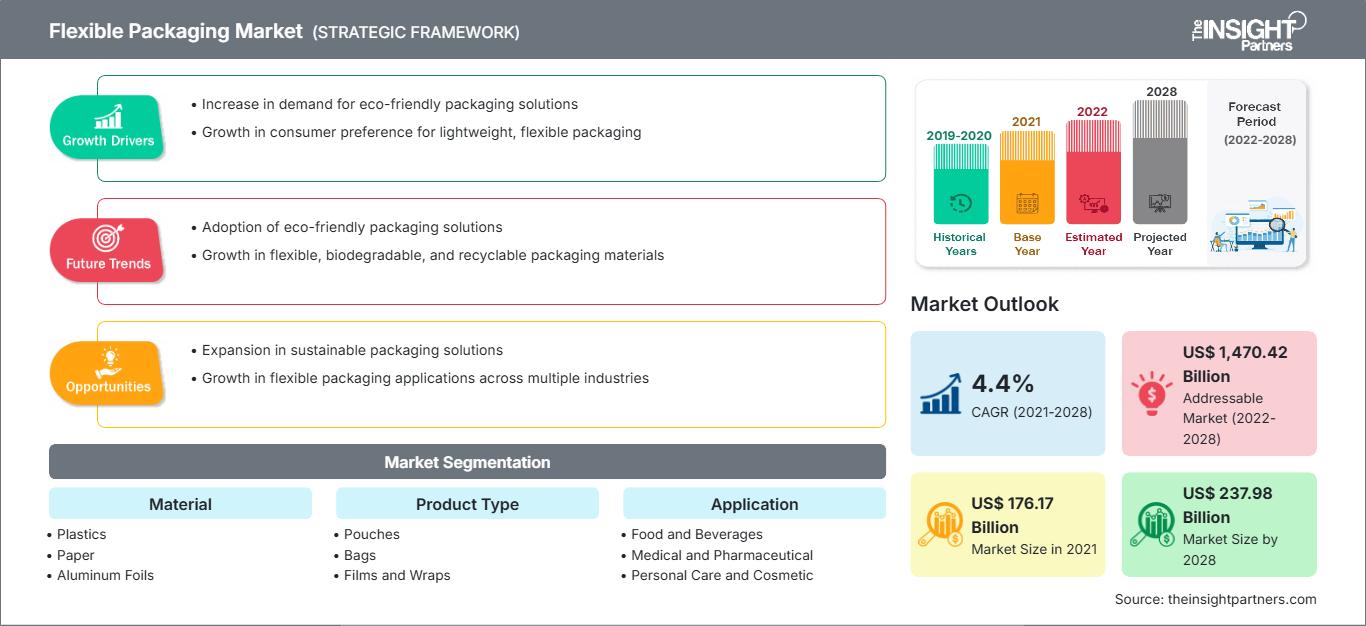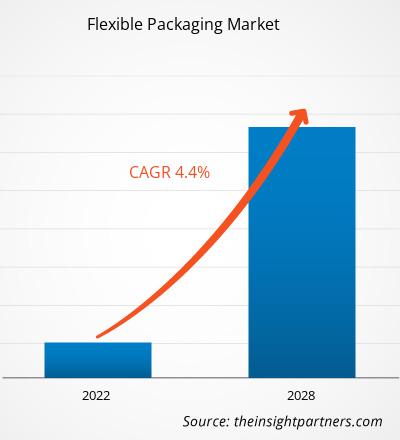フレキシブル包装市場は、2021年の1,761億7,361万米ドルから2028年には2,379億7,567万米ドルに達すると予測されており、2021年から2028年にかけて4.4%のCAGRで成長すると見込まれています。
フレキシブル包装には、ライナー、ポーチ、シール、サンプルパケット、バッグなどが含まれます。フィルム、プラスチック、紙、箔などで構成できます。さまざまな食品・飲料、消費財、音楽CD、医薬品、コンピュータソフトウェアパッケージ、栄養補助食品などに使用されています。フレキシブル包装の耐久性により、メーカーは目を引く高品質のカスタムデザインを印刷することができ、小売店での製品の視認性を高めることができます。
2020年、アジア太平洋地域は世界のフレキシブル包装市場で最大の収益シェアを占めました。アジア太平洋経済協力(APAC)によると、オーストラリアはAPACの先進国の一つです。食品・飲料セクターはオーストラリア最大の製造業であり、国内製造業全体の売上高の32%を占めています。オーストラリア食品・食料品協議会(AFSCA)の2019年業界動向レポートによると、食品・飲料、食料品、生鮮食品セクターの価値は853.2億米ドルです。この業界は、あらゆる規模の15,000社で構成され、273,000人以上の従業員を擁しています。成長を続ける食品・飲料業界は、フレキシブル包装市場を牽引しています。
要件に合わせてレポートをカスタマイズ
レポートの一部、国レベルの分析、Excelデータパックなどを含め、スタートアップ&大学向けに特別オファーや割引もご利用いただけます(無償)
フレキシブル包装市場: 戦略的洞察

- このレポートの主要な市場動向を入手してください。この無料サンプルには、市場動向から見積もりや予測に至るまでのデータ分析が含まれます。
レポートの一部、国レベルの分析、Excelデータパックなどを含め、スタートアップ&大学向けに特別オファーや割引もご利用いただけます(無償)
フレキシブル包装市場: 戦略的洞察

- このレポートの主要な市場動向を入手してください。この無料サンプルには、市場動向から見積もりや予測に至るまでのデータ分析が含まれます。
フレキシブル包装市場へのCOVID-19パンデミックの影響
製造ユニットの閉鎖、原材料調達の困難、物流の制限は、フレキシブル包装市場に悪影響を及ぼしました。しかし、COVID-19はオンライン食料品配達の大幅な増加をもたらしました。さらに、消費者がパントリーの補充に殺到するため、パッケージ食品および飲料業界では、乳製品を含む常温保存可能な食品および飲料の需要が急増しています。何百万もの世帯がピックアップまたは自宅配達のためにオンラインで食料品を購入するようになり、危機が過ぎ去った後も多くの人がeコマースのオプションを使い続けるでしょう。さらに、一般的に貯蔵寿命を延ばすために高バリア性の高級包装材料を使用する利便性重視の食品などの加工食品の需要の増加は、フレキシブル包装の必要性を促進する態勢が整っています。
市場インサイト加工食品の消費の増加飲料
Anu Food Brazilのレポートによると、ブラジルの食品小売セクターの総収益は2019年に960億米ドルでした。ブラジルの食品および飲料業界は、2019年に6.7%、2020年に12.8%の成長を達成しました。ブラジルでは冷凍食品市場が活況を呈しています。ブラジルの冷凍食品市場は、中流階級の拡大、購買力の向上、フルタイムで働く人の増加により活況を呈しています。したがって、インスタント食品に対する消費者の嗜好の高まりが、フレキシブル包装市場を牽引しています。
素材業界の洞察
素材に基づいて、世界のフレキシブル包装市場は、プラスチック、紙、アルミホイル、その他に分類されます。2020年には、プラスチックセグメントが世界のフレキシブル包装市場で最大のシェアを占めました。フレキシブルプラスチック包装には、さまざまな製品の包装に使用されるさまざまなタイプのプラスチック素材が含まれます。包装に使用される素材の種類は、包装する製品の用途と種類によって異なります。一般的に、フレキシブルプラスチック包装には、ポリエチレン、ポリプロピレン、ポリスチレン、ポリ塩化ビニルなどのプラスチック素材が使用されます。フレキシブル包装は、食品、飲料、医薬品、その他の消耗品の保存、配送、包装において、最も便利で経済的な方法と考えられています。
世界のフレキシブル包装市場で活動している主要企業には、Amcor plc、Huhtamaki、Mondi、Berry Global Inc.、Sealed Air、Sonoco Products Company、Coveris、Constantia Flexibles、Flexpak services、Transcontinental Inc.などが挙げられます。これらの企業は、顧客の要件を満たす高品質で革新的な製品の開発に注力しています。
フレキシブル包装フレキシブル包装市場の地域別分析
予測期間を通じてフレキシブル包装市場に影響を与える地域的な傾向と要因については、The Insight Partnersのアナリストが詳細に解説しています。このセクションでは、北米、ヨーロッパ、アジア太平洋、中東・アフリカ、中南米におけるフレキシブル包装市場のセグメントと地域についても解説しています。
フレキシブル包装市場レポートの範囲
| レポート属性 | 詳細 |
|---|---|
| の市場規模 2021 | US$ 176.17 Billion |
| 市場規模別 2028 | US$ 237.98 Billion |
| 世界的なCAGR (2021 - 2028) | 4.4% |
| 過去データ | 2019-2020 |
| 予測期間 | 2022-2028 |
| 対象セグメント |
By 材質
|
| 対象地域と国 | 北米
|
| 市場リーダーと主要企業の概要 |
|
フレキシブル包装市場のプレーヤー密度:ビジネスダイナミクスへの影響を理解する
フレキシブル包装市場は、消費者の嗜好の変化、技術の進歩、製品メリットへの意識の高まりといった要因によるエンドユーザーの需要増加に牽引され、急速に成長しています。需要の増加に伴い、企業は製品ラインナップの拡充、消費者ニーズへの対応のためのイノベーション、そして新たなトレンドの活用を進めており、これが市場の成長をさらに加速させています。

- 入手 フレキシブル包装市場 主要プレーヤーの概要
レポートの注目点
- フレキシブル包装業界の進歩的な動向。プレーヤーが効果的な長期戦略を策定するのに役立ちます
- 先進国と発展途上国の市場プレーヤーが採用しているビジネス成長戦略
- 2019年から2028年までのフレキシブル包装市場の定量分析
- フレキシブル包装の世界的需要の推定
- 業界で活動しているバイヤーとサプライヤーの有効性を示すポーターのファイブフォース分析
- 競争の激しい市場シナリオを理解するための最近の動向
- フレキシブル包装市場の成長を促進および抑制する要因、および市場動向と展望
- 商業的関心を支え、市場の成長につながる市場戦略を強調することにより、意思決定プロセスを支援
- さまざまなノードにおけるフレキシブル包装市場の規模
- 市場と業界の詳細な概要とセグメンテーションダイナミクス
- 有望な成長機会のあるさまざまな地域におけるフレキシブル包装市場の規模
- 過去2年間の分析、基準年、CAGRによる予測(7年間)
- PEST分析とSWOT分析
- 市場規模価値/数量 - 世界、地域、国
- 業界と競争環境
- Excel データセット
最新レポート
お客様の声
購入理由
- 情報に基づいた意思決定
- 市場動向の理解
- 競合分析
- 顧客インサイト
- 市場予測
- リスク軽減
- 戦略計画
- 投資の正当性
- 新興市場の特定
- マーケティング戦略の強化
- 業務効率の向上
- 規制動向への対応




















 無料サンプルを入手 - フレキシブル包装市場
無料サンプルを入手 - フレキシブル包装市場